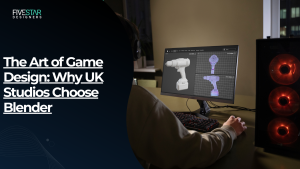Imagine using an app that no one owns, not a company, not a government, just the people who use it. That’s the world of decentralised applications, or dApps. These apps run on blockchain technology, giving users control instead of big corporations.
Today, the idea of “central control” is changing fast. With Web3, more people want open and fair systems. That’s where 5StarDesigners.UK steps in—helping businesses build smart, transparent, and secure digital solutions through blockchain.
So, let’s make sense of what a dApp is, how dApps work, and why they matter for the future of digital apps.
What is a dApp?
A dApp (short for decentralised application) looks like a normal app but works very differently. Instead of one company running it on private servers, it lives on a blockchain, a shared digital record that anyone can see.
How It Differs from Regular Apps
- Traditional apps store your data on a central server.
- Decentralised applications store data across a network of users.
- No single person can change or delete information secretly.
Examples You Might Know
- Ethereum dApps like Uniswap for crypto trading.
- NFT marketplaces such as OpenSea.
- Blockchain games where players own in-game assets.
These apps are transparent, secure, and owned by users, not companies.
How dApps Work: The Core Mechanism
To understand how dApps work, think of them as digital machines powered by blockchain. Every time you use a dApp, a smart code runs behind the scenes to make it happen.
Here’s How It Works
- You make an action, like sending a token.
- The app connects to the blockchain.
- A smart contract runs your request.
- The blockchain confirms and records it permanently.
These smart contracts are the brain of smart contract apps. They follow clear rules, no middlemen, no delays. Every action is checked and stored by many computers, not just one.
Understanding Blockchain dApp Development
Building a blockchain dApp takes skill and care. Developers design the front-end (what users see) and connect it to a blockchain using smart contracts.
Popular Blockchains for dApps
- Ethereum dApps – the most common and trusted.
- Solana, Binance Smart Chain, and Polygon – faster and cheaper options.
At 5StarDesigners, experts focus on security, testing, and smooth design. Each app is built for real-world use with strong safety checks and a simple user flow.
Ethereum dApps: The Foundation of Decentralisation
When people talk about decentralised applications, they often start with Ethereum dApps. Ethereum was the first major blockchain to support smart contracts.
Why Ethereum Matters
- It allows anyone to build and share dApps.
- It runs on the Ethereum Virtual Machine (EVM), which executes smart contracts securely.
- Some famous dApps include Aave, Uniswap, and OpenSea.
Gas fees and network speed can affect performance, but upgrades like Ethereum 2.0 are making things faster and cheaper.
Smart Contract Apps: Powering Automation and Trust
Smart contract apps are programs that do what they’re told, automatically. Once the rules are set, no one can change them.
Use Cases You’ll See Often
- DeFi lending and borrowing.
- NFT minting.
- Supply chain tracking.
- Voting systems for online communities.
They make apps fair and self-running. No one has to “trust” a central authority, the code itself ensures honesty.
Inside Decentralised App Architecture
A good decentralised app architecture keeps everything working together. Here’s what it includes:
- Front-end: What users see and use.
- Smart contracts: The code that does the work.
- Blockchain: Where all actions are stored.
- Middleware: Helps connect everything smoothly.
Compared to centralised systems, this setup is open and safer. But it also needs careful design to manage speed and data flow.
Advantages and Limits of Decentralised Applications
Advantages
- Safer: No single point of failure.
- Transparent: Anyone can check transactions.
- Fair: Users control their data.
Limits
- Slower than traditional apps.
- Higher transaction fees.
- Some are still hard for beginners to use.
Even so, new tech like Layer 2 solutions is fixing these issues fast.
Future of Decentralised Applications
The next few years look big for blockchain dApp development. dApps are spreading to gaming, healthcare, real estate, and education. With tools like AI and IoT joining the mix, expect smarter, faster, and more connected systems.
As Web3 grows, decentralised applications will likely become part of everyday digital life—just like websites or mobile apps are today.
How Businesses Can Benefit from dApps
Companies are starting to use decentralised applications for real business needs—like safer payments, clear records, and better privacy.
5StarDesigners.UK helps brands move from idea to launch with professional blockchain dApp development. Whether it’s finance, real estate, or digital art, they build secure and scalable dApps that people can trust.
Looking to Build Your Own dApp?
Partner with 5StarDesigners.UK, the UK’s trusted team for blockchain and decentralised app architecture. From concept to code, we create simple, secure, and powerful smart contract apps that work.
Visit 5StarDesigners.UK to get started today!
FAQs
What is a dApp, and how is it different from a regular app?
A dApp is a blockchain-based app with no central owner. Unlike normal apps, users control their data and actions.
How do dApps work on blockchain networks like Ethereum?
They run on blockchains using smart contracts. When users act, the code executes, and data gets stored on-chain safely.
What are smart contract apps, and how do they enhance decentralised applications?
Smart contract apps are automated programs that make dApps fair and self-running. They remove the need for middlemen.




